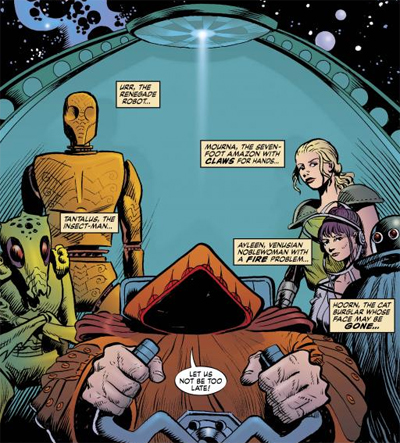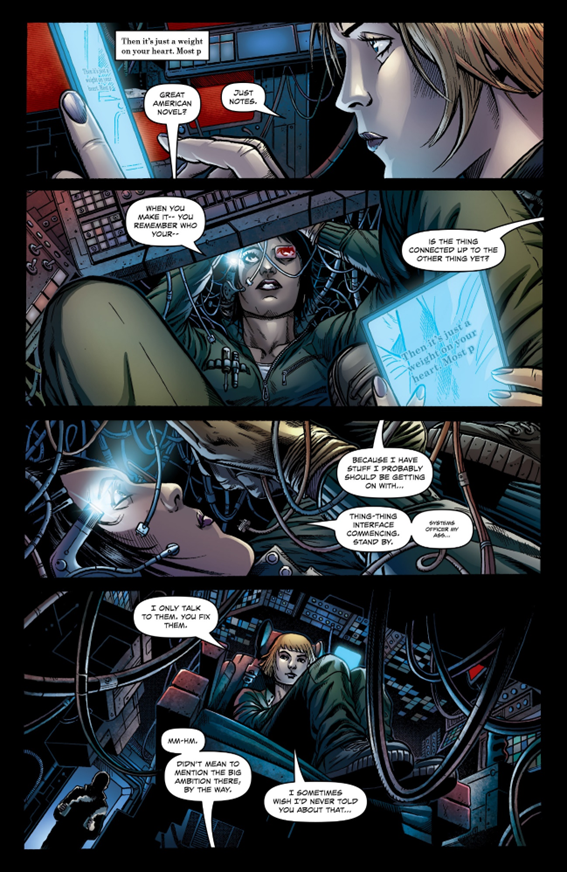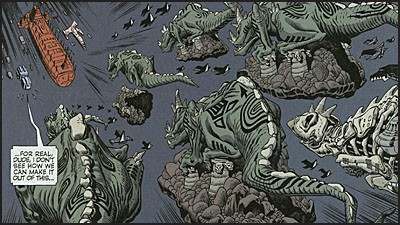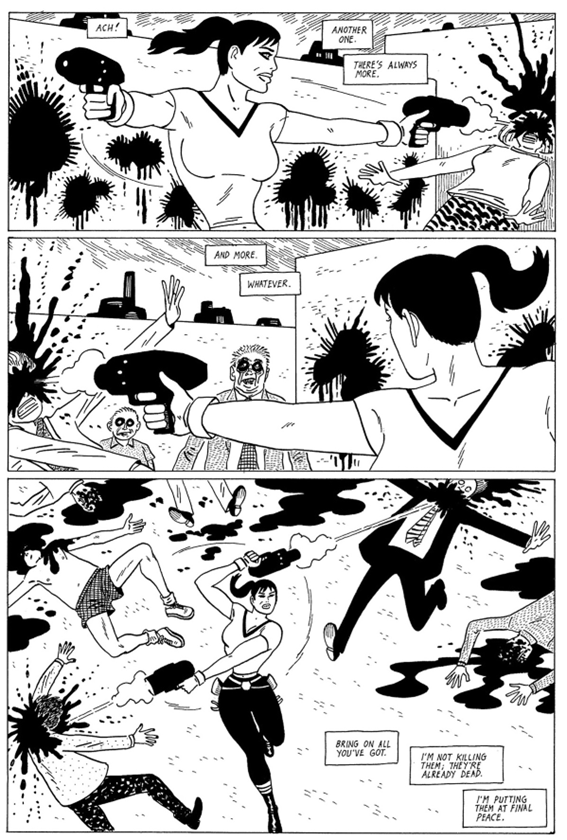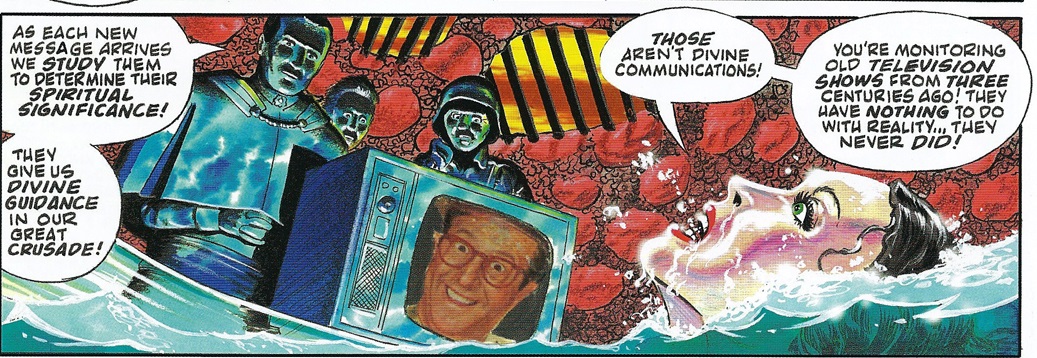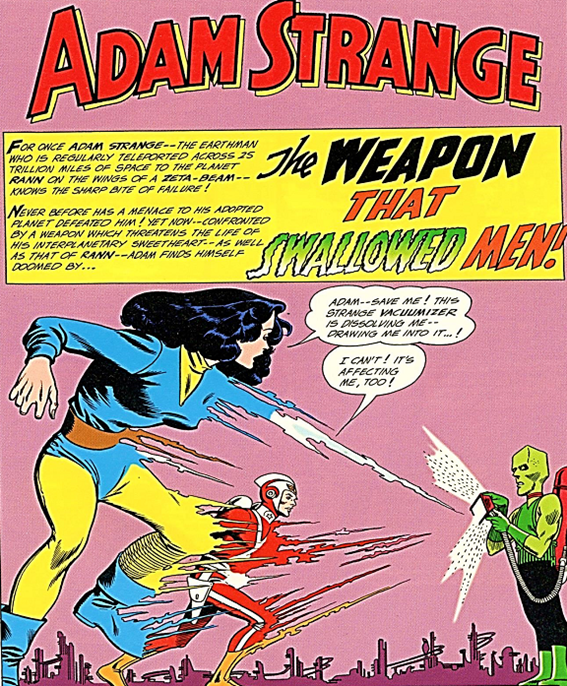After the remarkable Ex Machina, Alex Garland has now put together another tense, intelligent science fiction film in the form of Annihilation. The movie feels like a welcome reminder that, even though cinema tends to simplify the dense, heady tales it borrows from sci-fi literature, its pace and texture can nevertheless create a powerfully unsettling experience. To be sure, this is still a full-blown thriller at heart, but a refreshingly contemplative and engrossing one, even if the characters aren’t all that deep and even if it occasionally boils down to people shooting at bizarre-looking creatures.
Comics have produced their fair share of science fiction masterpieces, but Annihilation got me thinking more about near-misses – works with great potential that are clearly flawed yet remain interesting and somewhat satisfying, at least at the level of above-average comfort food. Some have compelling premises and ideas but treat them in a relatively uninspired way. Others recycle overused clichés but approach them with style and gusto. You get the feeling with several books that, if only they’d been given more room to find their voice, they could have morphed into something truly special.
I have a soft spot for many of these comics. While they’ll never become outright classics, they have enough cool elements inside to at least be worthy of cult status… Here are some that I suggest checking out:
7 AGAINST CHAOS
Penned by acclaimed writer Harlan Ellison, with solid (if old-fashioned) art by Paul Chadwick, this pulpy adventure yarn about a group of interplanetary misfits who are tasked with travelling back to the Pleistocene to save the fabric of reality sometimes looks like it’s on the verge of greatness, but it doesn’t quite get there. Frustratingly, 7 Against Chaos is plagued by an overbearing narration (often providing redundant or irrelevant information instead of letting the visuals carry the story) and an ultra-compressed pace (with the book rushing through key dramatic turns, thus lessening their impact). It also suffers from poorly developed characters (like Urr, who is introduced as an android that has established his own morality and can therefore rationalize breaching Asimov’s laws of robotics… a trait that never pays off!). Plus, the plot is pretty derivative – the first third of the story is a space opera version of Seven Samurai (a genre mash-up already done in the schlocky B-movie Battle Beyond the Stars) and the rest is mostly a run-of-the-mill team-on-a-mission quest with some hackneyed sword & sorcery imagery thrown in for good measure.
Still, once you accept these issues, there is a lot to like here (it helps if you pretend this is a lost comic from the seventies rather than an original graphic novel from 2013). Ellison packs the book with nifty little moments, like when the wave of entropy suddenly turns a CEO into a snake during a board meeting (‘They have no time to reflect on the aptness of the metamorphosis.’). Chadwick comes up with elegant designs and – along with colorist Ken Steacy – takes a chance to shine in the trippy time-travel sequence. And, above all, the climax is really strong: the heroes don’t just have to fight for their lives and sacrifice themselves for the mission, they also engage with a provocative ethical dilemma, leading up to a striking resolution.
CALIBAN
Garth Ennis has never been too shy about cannibalizing his favorite pictures. Just like Bloody Mary: Lady Liberty was a blatant riff on Escape from New York, Caliban is his take on Alien – according to interviews he gave at the time, he started toying with the idea when Prometheus was announced, imagining his own version of a prequel to Ridley Scott’s 1979 masterpiece (the book is even dedicated to H.R. Giger, ‘nightmare-builder’). This too is an alien-encounter horror tale set in a dark starship during a mining expedition, and the crew has the same grounded attitude as the one from the movie (a key theme established early on is that, even after conquering space, humans are bound to remain as grumpy and petty as always). The best part is that there is no xenomorph or a similar monster – the set-up may be familiar, but Ennis comes up with an original threat. Thus, Caliban captures the first film’s sense of dread as you keep trying to figure out what’s going on and the threat keeps evolving (this was something sorely lacking from the Alien sequels).
Facundo Percio is no Giger, yet he crafts a suitably eerie atmosphere, including a number of gruesome visuals, inked by Sebastian Cabrol and colored by Hernan Cabrera. You may occasionally find yourself flipping back and rereading a couple of pages because some of the settings and characters look slightly indistinguishable and the technobabble can get a bit thick, but I think that’s part of the fun – as talky as the comic can get, Garth Ennis excels at professional-minded, Hawksian banter.
Like Annihilation, Caliban also does a particularly swell job with the characterization of a gay female crew member… Ennis has written other strong-willed lesbian characters (namely in his Marvel Knights Punisher runs and in his Where Monsters Dwell mini-series), yet they tend to show up in a comedic context, whereas here that subplot actually pays off in quite a touching way.
CLEAR BLUE TOMORROWS
This 2001 Belgian graphic novel (recently published in English by Cinebook) is basically an anthology with an amusing framing device: an old man travels from the future to the present day in order to prevent scientist/businessman (and failed novelist) F.G. Wilson from taking over the world… however, because he cannot kill Wilson, he tries to lead the would-be tyrant away from the path of world domination by encouraging his writing career. We thus get a handful of story pitches – based on the old man’s memories from the future – that ultimately work as short, self-contained tales, usually with a touch of satire.
The whole thing is penned by Fabien Vehlmann, who is a pretty entertaining genre writer. And while the stories in Clear Blue Tomorrows are your typical mixed bag, all of them are a joy to read thanks to the cartoony, light-as-a-feather art of Bruno Gazzotti and Ralph Meyer, with colors by Bernard Devillers. High points include a prison tale in which a warden controls the inmates by getting them hooked on a cheesy soap opera, a thriller set in the sewers during the Super Bowl (under the looming threat of that collective flush in the ad break), and a futuristic spin on the Judgement of Solomon.
When indie creators who are mostly known for their dramatic works venture into pure genre territory, the results are often intriguing, but don’t always hold up very well on their own. Take, for example, Daniel Clowes’ Patience, which got so much praise a couple of years ago: it is surely an interesting entry into Clowes’ oeuvre (in that it channels his pet themes and tone in a new context), but as a sci-fi adventure it isn’t very clever, creative, fun, or thought-provoking (even if it is each of those things to some degree). While Patience’s main appeal was to read a Clowes comic with a sci-fi twist, though, in the case of 2012’s Fatima: The Blood Spinners the appeal was to read a sci-fi comic with a Gilbert Hernandez twist. The famed creator of the moving Palomar tales threw himself at this post-apocalyptic zombie-infection yarn with flair and zest, embracing the cheap thrills of splatterpunk in all their trashiness while delivering a kickass grindhouse ride.
Fatima doesn’t break any new ground in terms of characters (a gun-toting babe with a haunting past and a grim attitude, a group of sleazy mad scientists) or concepts (a powerful designer drug, a shady conspiracy), but Hernandez takes the familiar trappings and makes them his own. He goes particularly over-the top with the action, most pages featuring gleeful shoot-outs and gory violence. And, as usual, Beto draws mesmerizingly huge-breasted women (including a couple of bikini-clad blondes who set up a nice gag), although in this kind of story it feels like an apt homage to Russ Meyer’s exploitation flicks, such as Faster, Pussycat! Kill! Kill!.
For all its well-trodden tropes, The Blood Spinners is a strange little beast that keeps moving relentlessly – a sudden plot turn here, a jarring jump-in-time there, a brief romantic detour – at an offbeat pace, punctuated by hordes of exploding heads.
HEARTBURST
A human colony in a faraway planet that has become so out-of-touch with Earth that their belief system is based on deciphering old television shows (‘The Sponsor in all his glorious manifestations is beaming them at us!’)? A Gene Police, run by Inquisitor Xerox, in a brutal crusade against human-alien miscegenation? An atomic colonial war? A means of travelling throughout the galaxy that relies on heart and dreams? A twisted send-up of religion, apartheid, and the military, full of sex and disturbing imagery, as well as a trace of New Age sensibility?! This is what you get when you give creative freedom to Rick Veitch, one of the most fascinating voices in the world of comics, who not only wrote Heartburst, but also provided its feverish art and psychedelic colors.
Heartburst was originally published in 1984, but Veitch released it again in 2008 – in the collection Heartburst and Other Pleasures – together with a handful of brief experiments (including the illustrated poem ‘The Mirror of Love,’ a homage to same-sex love and its role in culture, written by Alan Moore).
PULP FICTION LIBRARY: MYSTERY IN SPACE
In 1999, DC put out a wonderful collection called Pulp Fiction Library: Mystery in Space, with thirty-three short stories published between 1946 and 1981, shaped by utopian dreams and nuclear nightmares. The collection includes works by a host of notable creators, such as writers Gardner Fox, Otto Binder, Robert Kanigher, Len Wein, and Gerry Conway, as well as artists Frank Frazetta, Murphy Anderson, Jim Mooney, Alex Toth, Carmine Infantino, Gil Kane, and Joe Kubert, among many others. There are also neat introductory texts by Larry Niven and Stuart Moore.
While the quality varies, the comics are overwhelmingly interesting and/or fun: some make outlandish predictions (‘How Television Will Change Your Future’ predicts a world with live newscasts!), others engage in believable scientific speculation (in ‘Just Imagine – if the Sun Went Out!,’ humans nuke the moon until it becomes a new sun), some have more of a dark vibe (‘Spores from Space’ could have come out of EC Comics), others are lighthearted escapist fare (‘I Hunted Big Game in Outer Space’ is exactly what it sounds like), some are merely droll (‘Brief Encounter’ delivers a quirky joke without overstaying its welcome), others are totally bonkers (‘The Man with 100 Lives!’ finishes with the beautiful line: ‘The day will come when all crime will realize there’s no victory against the science of law and order!’), a few of them are close to brilliant (‘Killing Time’ has one hell of a final page), and many are your quintessential pulp adventure, full of ray guns and jetpacks (some even feature DC heroes such as Adam Strange and the Atomic Knights).
The appeal is not just to see how the future kept being reimagined throughout the decades, but also to appreciate the shifts and continuities in the language and visuals of sci-fi comics, from the dynamic, quasi-surrealist drawings of Jack Kirby, Dick Sprang, and Virgil Finlay in the mid-1940s to the stylish art of Tom Yeates, Brian Bolland, and Rick Veitch in the early 1980s.

